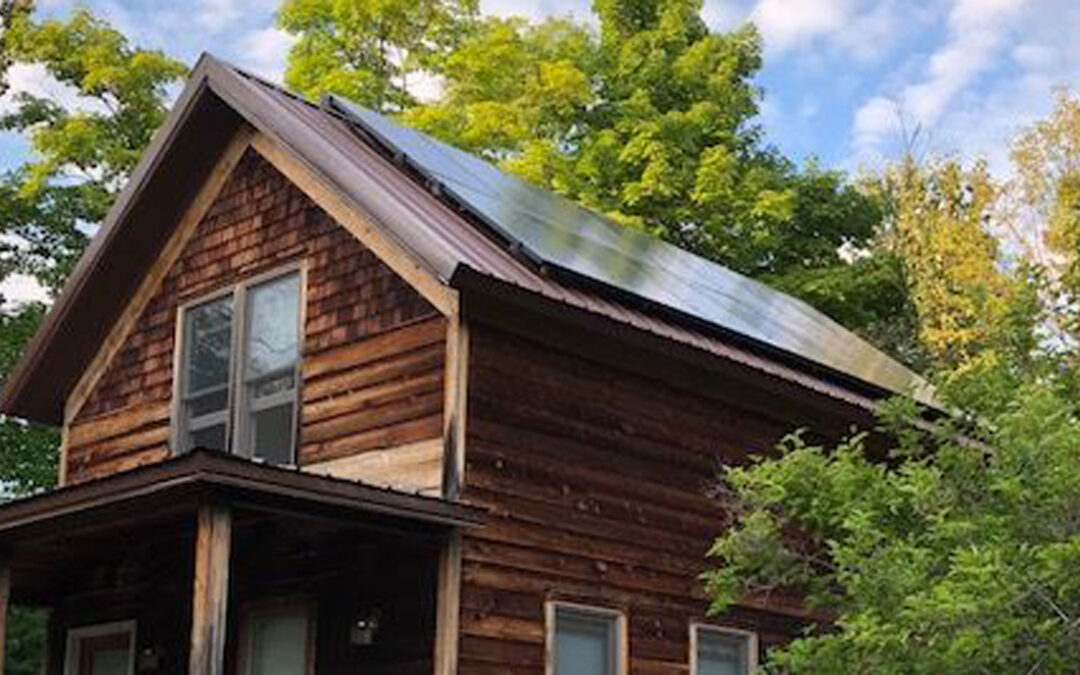
by Heather Allen | Jan 28, 2021 | Advocacy, Community, Policy, PSC Priorities, Public Service Commission, RENEW Wisconsin, Renewables, Solar
COAUTHORS: Michael Vickerman and Lauren Reeg
Wisconsin’s distributed generation (DG) renewable energy market lags behind comparable states.[1] As seen in other states, DG helps diverse groups of individuals and organizations, including businesses, residents, renewable energy customers, and future renewable energy customers, gain access to renewable energy and create a more fair and navigable market.
Whether it takes the form of behind-the-meter generators powering individual customers or larger projects feeding power directly into the distribution grid, DG is a vitally important segment of the renewable energy landscape. Customer investments drive these installations with benefits extending to Wisconsin businesses, residences, governments, nonprofits, and their communities. DG clean energy investments help spur local economic investment, support clean energy jobs, and save Wisconsin money that otherwise would have been spent on importing fossil fuels.
It has long been RENEW’s view that a more fair, clear, and consistent regulatory environment could strengthen the DG market and accelerate the transition to renewable energy in Wisconsin.
In June 2020 the Public Service Commission of Wisconsin (PSC) convened an investigative docket” (5-EI-157) to identify regulatory barriers that effectively put a tight lid on Wisconsin’s DG market, especially customer-sited DG.
This investigation is structured to encourage input and recommendations from organizations and entities that support small-scale DG. RENEW has assembled an expert legal and technical team for this docket—Tim Lindl and Melissa Birchard of Keyes and Fox, and Justin Barnes of EQ Research. We invite you to review the legal and policy analysis we provided to the PSC in August 2020 and in January 2021.[2] A coalition of organizations (Clean Energy Advocates) joined our comments to the PSC, demonstrating broad support for an improved DG market. This ongoing investigation is the best opportunity we’ve had in more than 10 years to advance renewably powered DG before the PSC.
The success of this campaign will strengthen and expand the renewable DG market in Wisconsin. If you support this work, please consider a donation to RENEW today. Together we can champion renewable energy growth in Wisconsin and we are poised to make significant progress in 2021. Join us today!
Wisconsin has fewer net metering customers than comparable states
Net metering customers represent an important segment of the renewable energy market, however, Wisconsin is falling behind. In the last four years, net metered customers in Wisconsin have grown by only 0.11%, well below the increases seen elsewhere in other states since 2015.
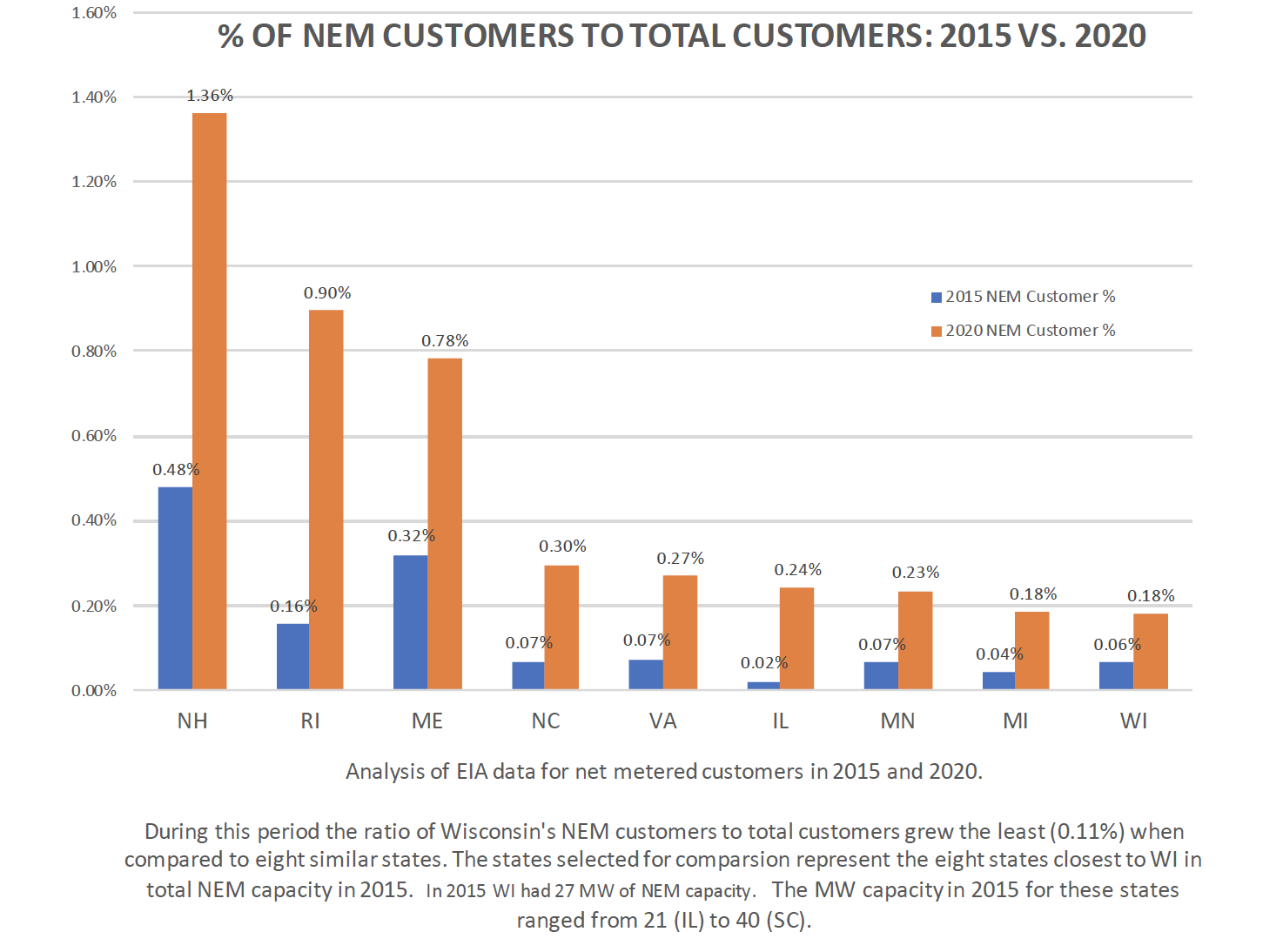
Fair and clear distributed generation policies would grow the renewable energy market in Wisconsin
RENEW Wisconsin aims to enlarge the market share for non-utility-owned renewable DG, including both self-supply and grid-supply projects. In furtherance of that goal, we’ve developed a number of principles that should inform decisions rendered in the DG docket. These include:
- Ensuring developer access to standard offer contracts that have terms for reasonable compensation.
- Giving developers insight into system and utility resource needs to help them target their planned investments.
- Provide larger energy users with better and less restrictive opportunities for larger self-supply resources.
- Standardize and improve net metering rates for all customers across Investor-owned Utilities (IOUs).
In addition to behind-the-meter systems, RENEW has also set forth a path for front-of-meter renewable generation projects up to 20MW. These types of projects should be eligible for 20-year standard offer contracts that are pegged to the same methodologies that utilities use when assigning value to their own generation projects. Leveling the playing field for compensating solar is essential to increasing customer investment opportunities, and expanding the solar workforce.
RENEW is optimistic that by the end of the docket the PSC will land on several beneficial policy changes for promoting renewable DG. These policy changes could be taken up later this year through the anticipated utility rate case filings. Should events unfold along these lines, solar developers and customers stand ready to benefit from a more fair, clear, and consistent renewable energy market.
Join RENEW’s campaign to advance renewable distributed generation in Wisconsin
Since 1991, RENEW has been the state’s preeminent advocate for renewable energy. At the macro scale, solar and wind can outcompete fossil fuels on cost and environmental performance. For the first time in more than a decade, we have an opportunity in Wisconsin to broaden the clean energy transition underway to benefit all customers who place a value in a healthy energy economy. A clear, fair and forward-looking regulatory environment will be crucial to spreading renewable energy across all sectors of society. RENEW is bringing together the leadership and expertise necessary to undo the regulatory barriers that have held renewable DG back, and to replace them with policies to make renewable DG more accessible, affordable, and plentiful across Wisconsin. We hope you will join us in this work by donating today. 2021 promises to be an exciting year!
[1] RENEW evaluated eight states closest to Wisconsin in terms of cumulative Net Energy Metering (NEM) capacity at the end of 2015, i.e., the four states immediately above and below Wisconsin in EIA data listing NEM capacity by state. The eight states closest to WI in NEM capacity in 2015 included NH, RI, ME, NC, VA, IL, MN, and MI. The 2020 data is based on NEM capacity through April 2020. The percentage of total customers uses 2018 total state customer counts for both calculations. Note that Wisconsin has fallen behind states it had previously led. See bar graph for more information.
[2] In the most recent comments filed by Clean Energy Advocates, we looked at this year’s PSC calendar to assess how our recommended actions can make their way into regulatory policy. The DG docket now underway is well-timed in that we expect every Class A investor-owned utility in Wisconsin to file for new rates in 2021.
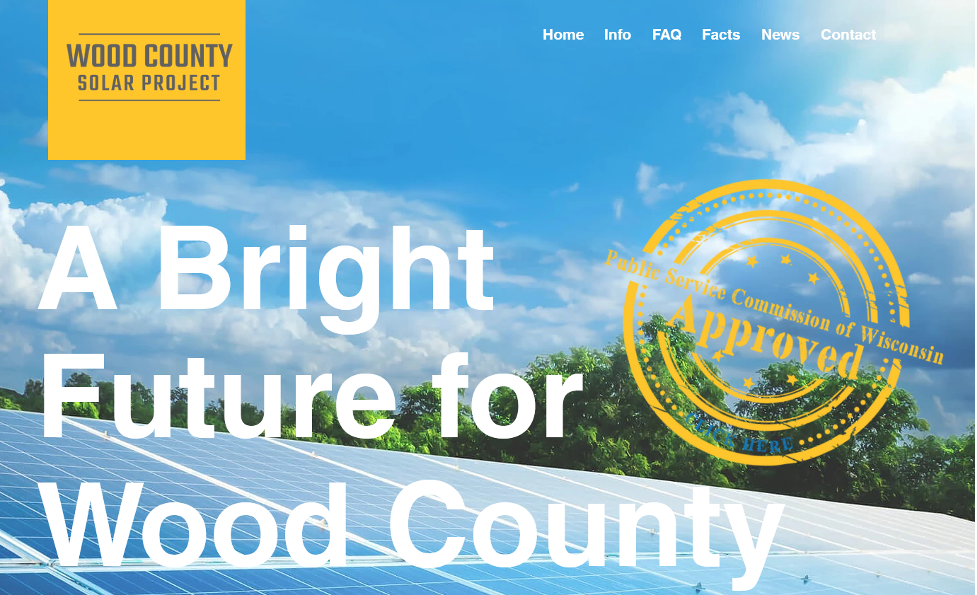
by Michael Vickerman | Jan 26, 2021 | Public Service Commission, Solar, Utility Scale
At its first open meeting of 2021, the Public Service Commission (PSC) cleared the path for Wisconsin’s next solar farm, a 150 megawatt (MW) project near Wisconsin Rapids in Wood County, to proceed to construction. Developed by Savion Energy, the Wood County Solar Farm is one of six Wisconsin solar farms totaling 675 MW that Alliant Energy-Wisconsin Power and Light seeks to acquire for its own generating fleet.
Wood County is the sixth solar farm proposal to be granted a siting permit from the PSC since April 2019, when the agency approved Wisconsin’s first two solar farms, Two Creeks and Badger Hollow. With the authorization of the Wood County project, total solar power capacity approved by the PSC climbed above one gigawatt (see Table 1).
With this favorable ruling, four of the six solar farms that Alliant Energy plans to acquire now have permits. In addition to Wood County, the other permitted solar farms are Crawfish River, a 75 MW project near Jefferson, North Rock, a 50 MW project near Edgerton, and Richland County Solar, a 50 MW project near Lone Rock, also developed by Savion Energy (see Table 2).
Two other proposed solar farms—the 200 MW Grant County project near Potosi and the 150 MW Onion River project near Oostburg in Sheboygan County–are moving through the regulatory review process. The PSC is expected to issue rulings on those two projects, along with Alliant’s application to own and operate all six solar farms, over the next three months.
Presently, the site is mostly a red pine plantation grown for the pulp and paper industry. Following PSCW approval of Wood County Solar Project, the work to harvest the site’s existing stand of trees will begin. Coordination has already commenced between the Project, Alliant Energy, The Town of Saratoga, and Wood County to ensure an orderly harvesting campaign.
Though the parcel has been a working tree farm since 1938, development pressure has been intensifying in recent years. In 2012, the Wysocki Family of Companies applied for permits to establish a 3,500-cow dairy operation on that property, and over time the proposal grew to approximately 5,300 cows. The residents of the Town of Saratoga fought the dairy proposal vehemently, in part to protect drinking water wells that supply many of the local families. The solar farm has received wide support in the community.
The construction timetable calls for the completion of the solar farm in the fourth quarter of 2022.
| Table 1: PSC-approved solar power projects since 2019 |
| Project name |
Capacity
(in MW) |
Applicant |
County |
| Two Creeks |
150 |
NextEra Energy |
Manitowoc |
| Badger Hollow |
300 |
Invenergy |
Iowa |
| Point Beach Solar |
100 |
NextEra Energy |
Manitowoc |
| Badger State Solar |
149 |
Ranger Power |
Jefferson |
| Paris Solar |
200 |
Invenergy |
Kenosha |
| Wood County |
150 |
Savion |
Wood |
| Total |
1,049 |
|
Table 2: Solar power projects proposed for Alliant-WPL’s generation portfolio
(Docket No. 6680-CE-182) |
| Project name |
Capacity
(in MW) |
Applicant |
Siting permit status |
| Wood County |
150 |
Savion |
Approved |
| Grant County |
200 |
NextEra Energy |
Docket underway |
| Onion River |
150 |
Ranger Power |
Docket underway |
| Crawfish River |
75 |
Ranger Power |
Approved |
| North Rock |
50 |
National Grid |
Approved |
| Richland County |
50 |
Savion |
Approved |
| Total |
675 |
|
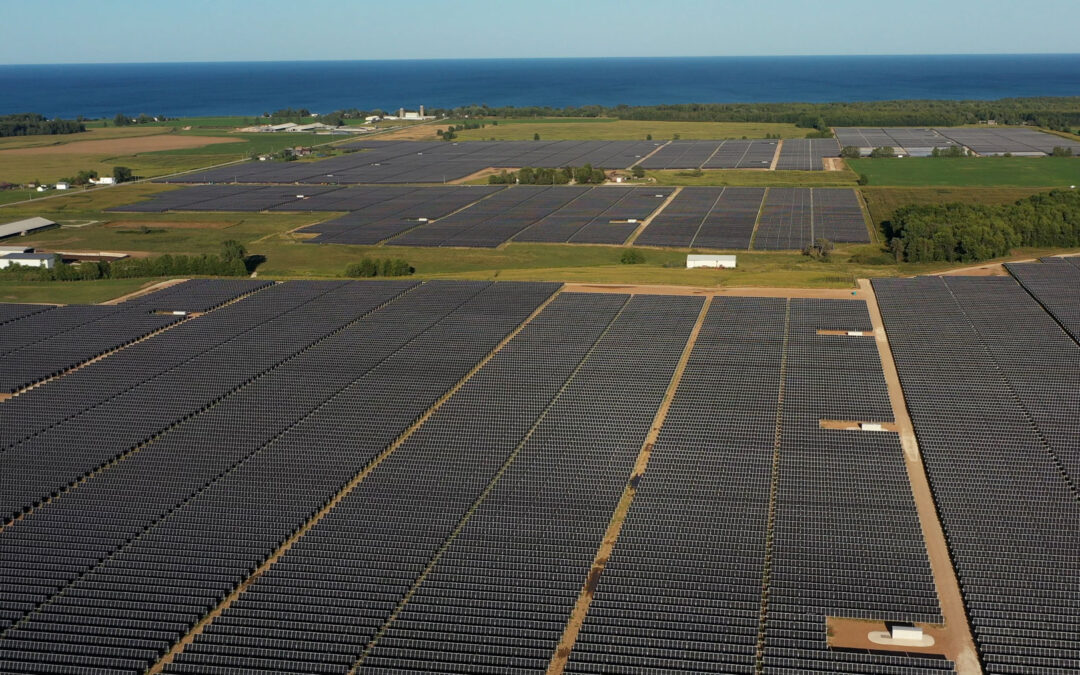
by Michael Vickerman | Nov 15, 2020 | Public Service Commission, Renewables, Solar, Utilities, Utility Scale
The Two Creeks Solar Park, located in Manitowoc County, was energized last week, becoming the state’s largest generating station powered by the sun. Developed by Florida-based NextEra Energy, Two Creeks is jointly owned by two Wisconsin electric utilities: Wisconsin Public Service Corporation (WPS) and Madison Gas and Electric (MGE). WPS owns and operates a 100 megawatt (MW) share of the 150 MW power plant, while MGE has the remaining 50 MW share.
Located next to the Point Beach Nuclear Plant, Two Creeks effectively doubles the amount of solar generating capacity in Wisconsin to 300 MW, and will, over the next six months, produce more electricity than the combined output from all other existing solar systems in Wisconsin. Expected to produce more than 300,000,000 megawatt-hours a year, Two Creeks will generate about one-half of one percent of the state’s overall supply of electricity, which is the equivalent of what 33,000 residences consume annually.
Along with the 300 MW Badger Hollow Solar Farm in Iowa County, Two Creeks received approval from the Public Service Commission (PSC) in April 2019. These two were the pioneering solar farm proposals that navigated through the PSC’s power plant siting process and won approval from the agency. At the same meeting, the PSC granted a joint request from WPS and MGE to acquire Two Creeks.
Since then, the PSC has given the green light to two more solar farms totaling 249 MW in capacity, including NextEra Energy’s 100 MW Point Beach Solar Farm next door to Two Creeks. Point Beach Solar is under construction and should be completed in the fall of 2021.
Construction work on Two Creeks commenced on August 2019, kicked off with a groundbreaking ceremony that drew Gov. Tony Evers and the two utility ceos. Governor Evers’ appearance came less than a week after he issued Executive Order 38, articulating a goal of “ensuring all electricity consumed within the State of Wisconsin is 100% carbon-free by 2050.”
Building Two Creeks was no small undertaking. It involved punching thousands of posts into the ground to support horizontal tracking systems spreading across 800 acres of relatively flat terrain. Mounted on these rotating poles are more than 500,000 panels that follow the sun as it crosses the sky going east to west. Between the first rays of sunlight and the last ones before sunset, these panels soak in the sunshine and convert it to electricity.
A plant like Two Creeks will begin displacing higher-cost power at the moment it is energized, and these savings will grow significantly over the course of its 30-to-50-year life. True, the utilities will need to recover the cost of building the solar farm, somewhere in the vicinity of $195 million. But the savings utilities expect to reap from avoided fossil fuel purchases and pollution control expenditures will more than outweigh their investment in a zero-carbon generation source. Seen in this light, large-scale solar is indisputably the most cost-effective supply option that an electric utility can pursue going forward.
The benefits from Two Creeks extend beyond ratepayer savings. Manitowoc County and the Town of Two Creeks, the jurisdictions hosting the solar farm, expect to reap a combined $600,000 in local aids each year while the project remains in service. That number grows to $18,000,000 over the course of 30 years, which is the projected minimum lifespan of Two Creeks.
Solar is a noncombustible energy resource that does not emit any gaseous emissions or particulates when converted to electricity. Deploying solar at the scale of Two Creeks will capture significant public health and air quality benefits by avoiding emissions that are associated with conventional fossil generation plants. In another PSC proceeding involving a 15O MW solar farm in eastern Wisconsin, the developer anticipates annual emissions reductions in the following categories of pollutants: (1) nitrogen oxide (NOx) emissions by 195,000 pounds; (2) methane (CH4) by 20,000 pounds; (3) nitrous oxide (N2O) by 5,000 pounds; and (4) carbon dioxide (CO2) by 405 million pounds.
Decarbonizing the state’s fleet of power plants is also a job creation strategy. The PSC estimates that somewhere between 200 and 300 jobs were created during the project’s construction window. It’s quite likely that many of the workers involved in the building of Two Creeks are now hard at work constructing the adjoining Point Beach solar farm.
In the annals of Wisconsin electric utility history, Two Creeks represents a noteworthy milestone, as the first solar farm to clear the PSC’s power plant review process and become a valuable addition to the state’s portfolio of power plants. And it took only 18+ months from the crossing of the regulatory finish line for Two Creeks to start sending power into the grid.
Two Creeks can also be viewed as the lead entry in a parade of large solar farms seeking to cross the same regulatory finish line and proceed to construction and completion. Looking out over the next 12 months, the PSC will review and make decisions on six solar farm applications totaling 1,150 MW (see table below).
| Project name |
Developer |
County |
Capacity
(in MW) |
Anticipated decision date |
| Paris |
Invenergy |
Kenosha |
200 |
11/2020 |
| Wood County |
Savion |
Wood |
150 |
12/2020 |
| Grant County |
NextEra Energy |
Grant |
200 |
4/2021 |
| Onion River |
Ranger Power |
Sheboygan |
150 |
5/2021 |
| Darien |
Invenergy |
Walworth/
Rock |
250 |
7/2021 |
| Apple River |
National Grid |
Polk |
100 |
9/2021 |
| Springfield |
National Grid |
Dodge |
100 |
9/2021 |
Within that same 12-month window, we expect two more PSC-approved solar farms—Badger Hollow I (150 MW) and Point Beach (100 MW) to cross the finish line and begin generating electricity.
What we’re seeing here is the emergence of a new resource paradigm that is ushering in a major wave of public works construction across the state. As this transition unfolds, solar power will become widely recognized as a linchpin in the state’s economy, extending through this decade and beyond.
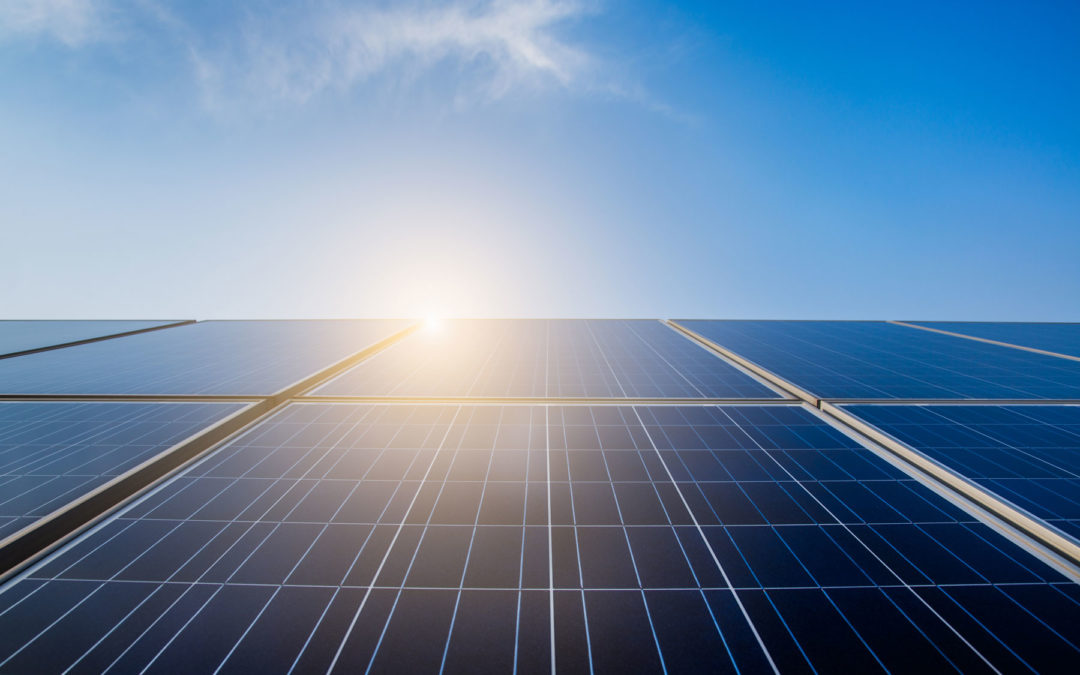
by Michael Vickerman | Nov 6, 2020 | Electric Vehicles, Energy Storage, Programs, Public Service Commission, Solar
Update: The Request for Proposals (RFP) pursuant to the 2020 grant cycle of the Energy Innovation Grant Program has been posted on the Public Service Commission’s web site. You can access the RFP here. The due date for grant submissions is January 22, 2021.
October 19, 2020
The Public Service Commission approved $7 million in funding that will be awarded through the 2020 round of the Energy Innovation Grant Program (EIGP). The EIGP awards financial assistance that supports the Office of Energy Innovation’s mission relating to energy efficiency, renewable energy, transportation, planning and resilience. In the previous round in 2018, the EIGP distributed nearly $5 million to more than 100 recipients. EIGP presently has a cash balance of more than $26 million.
The final order (PSC REF# 398392) was issued on October 16th, setting forth elements including (1) eligibility criteria; (2) eligible activities; (3) program budget; (4) procedures for tracking and reporting; and (5) development of the Request for Proposals (RFP).
The most important decisions rendered by the Commission are itemized below, interspersed with tables providing greater granularity on the program design and schedule.
Key decisions
- The following entities are eligible to seek funds through this program: manufacturers of all sizes; and cities, villages, towns, counties, K-12 school districts, tribes, municipal water and wastewater utilities, municipal electric utilities, municipal natural gas utilities, University of Wisconsin System campuses and facilities, Wisconsin Technical College System, public or nonprofit hospitals, and 501(3)(c) nonprofits (collectively MUSH Market).
- A budget of $7 million was authorized for the upcoming round. This represents an increase of $2 million from the previous round. The allocations for each of the four program activities are listed below.
- Projects involving all statutorily defined renewable energy resources are eligible for funding.
- The additional $2 million were allocated to Activities 1 and 2.
| Optional Available Funds Per Activity for 2020 Program Year |
| Activity |
Maximum grant request |
Available funds per activity |
| 1. Renewable Energy + Energy Storage |
22% up to $250,000
(solar PV only) |
$2.5 million |
| $500,000 (other RE) |
| $250,000 (energy storage system) |
| $500,000 (solar + storage) |
| $750,000 (other RE + storage) |
| 2. Energy Efficiency + Demand Response |
$1 million |
$3 million |
| 3. Electric + RNG Vehicles + Infrastructure |
$100,000 |
$1 million |
| 4. Comprehensive Energy Planning |
$100,000 |
$500,000 |
| Total |
|
$7 million |
The Commission also approved a timeline for the upcoming round of funding, the milestones of which appear in the table below.
| Tentative 2020 Energy Innovation Grant Program Year Timeline |
| Date |
Activity |
| 9/2020 |
PSC consideration of 2020 Grant Program Design – final order issued |
| 10/2020 |
Final order issued; Circulate RFP 90-day application period |
| 1/2021 |
Applications due |
| 2/2021 |
Review and score proposals |
| Spring 2021 |
2020 EIGP Award recommendations considered; announce awards |
| Spring 2021 |
Contract negotiations; sign award agreements |
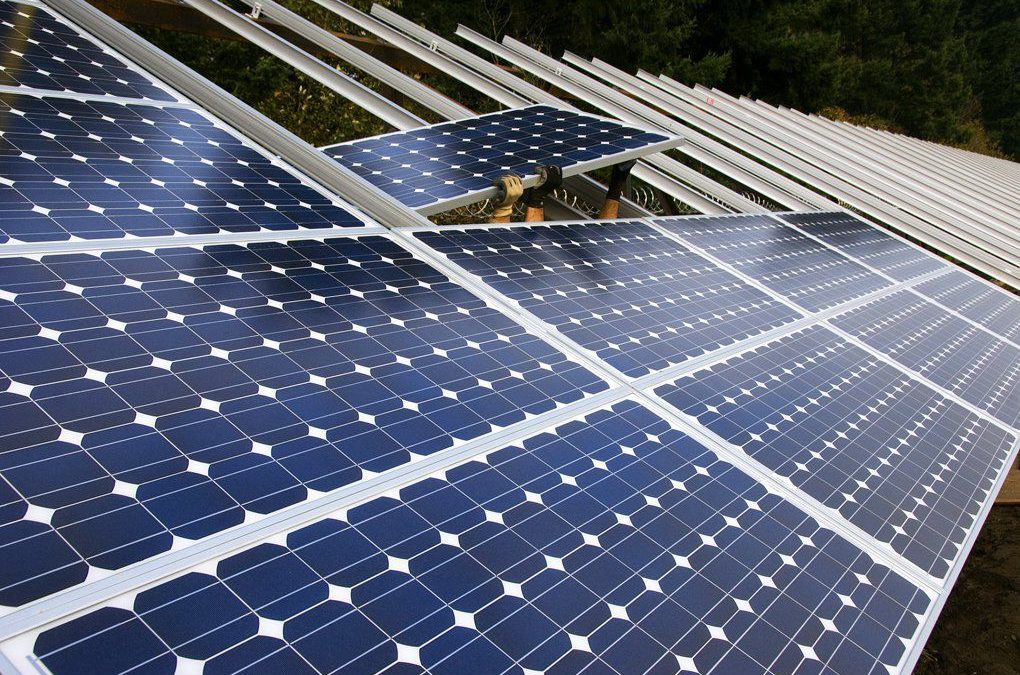
by Michael Vickerman | Oct 7, 2020 | Focus on Energy, PSC Priorities, Public Service Commission
Now entering its 20th year of operation, Wisconsin’s Focus on Energy program is widely recognized as a model public benefits program delivering energy savings to utility customers. This statewide program, funded entirely through utility bills, provides incentives and other services to help households, businesses, and nonprofits invest in energy efficiency measures and supply themselves with clean energy.
Take Capital Brewery as an example. With financial support from Focus on Energy, the Middleton brewery and beer garden installed in 2014 a high efficiency heat recovery system with controls and a 13 kilowatt (kW) solar electric system on its roof. Thanks to these investments, Capital Brewery saves more than $4,500 each year on its heating and electricity bills.
Capital Brewing’s Wisconsin peers are also capturing the energy value of sunshine. Breweries such as Central Waters, Ale Asylum, New Glarus, Bare Bones, and Lakefront have parlayed incentives from Focus on Energy into investments in onsite solar power. In so doing, they demonstrate that incorporating sustainability and carbon reduction into their operations is good business and can often be a competitive advantage.
According to its web site, Focus on Energy has enabled millions of ratepayers to save $730 million in avoided energy costs since the program’s inception. Moreover, it has been a consistently powerful economic engine for the state of Wisconsin, yielding between $4 and $5 in economic and avoided pollution benefits for every $1 spent by the program.
But to fully appreciate Focus on Energy’s reach and impact, it’s worth reading through the dozens of energy efficiency and clean energy success stories made possible by program incentives. As these testimonials and case studies make clear, Focus offerings have something of value for every electric customer in Wisconsin, no matter how large or small they may be.
On the renewable energy side, virtually every solar photovoltaic (PV) system powering Wisconsin residences and small businesses today received a rebate from this unique, ratepayer-funded program. Nowadays, with solar installation prices down to about a quarter of where they were 10 years ago, Focus on Energy can award rebates to many more customers than in the past. Notwithstanding the ongoing pandemic, 2020 is shaping up to be a record-breaking year in the residential solar market, fueled by $2.3 million in incentives from Focus on Energy.
The popularity of its solar incentives is putting a strain on Focus on Energy’s budget going into 2021. Under its current four-year plan, the program reserves $5.5 million each year for all qualifying renewable energy investments, out of an annual budget overall of about $95 million. Increasing its overall budget would require approval from state legislators. Absent such action, Focus on Energy has little choice but to pare residential rebate levels down to $500 per installation going forward.
Electric providers throughout Wisconsin contribute 1.2% of their gross revenues into Focus on Energy. Though they are not required to participate, all of the municipal utilities and nearly half of the electric cooperatives in Wisconsin also fund the program, to the tune of $8 a year per meter.
As the overseer of Focus on Energy, the Public Service Commission (PSC) is very mindful of the demands placed on the program, and its crucial contribution to reducing fossil energy consumption and greenhouse gas emissions. To that end, PSC Chair Rebecca Valcq is asking Governor Evers to put an additional $100 million into the program, starting in July 2021. According to the PSC, the increase would cost residential households less than a $1/month.
“These programs reduce emissions,” Valcq said. “They reduce the need to go out and look at building generation and transmission projects. These programs create jobs.”
Signed into law by Governor Tommy Thompson back in 1999, Focus on Energy has enjoyed strong bipartisan support throughout its history. Considering how broadly its benefits have been spread throughout the state, increasing the program’s budget should be something both Republicans and Democrats can agree on.
Michael Vickerman is policy director of RENEW Wisconsin
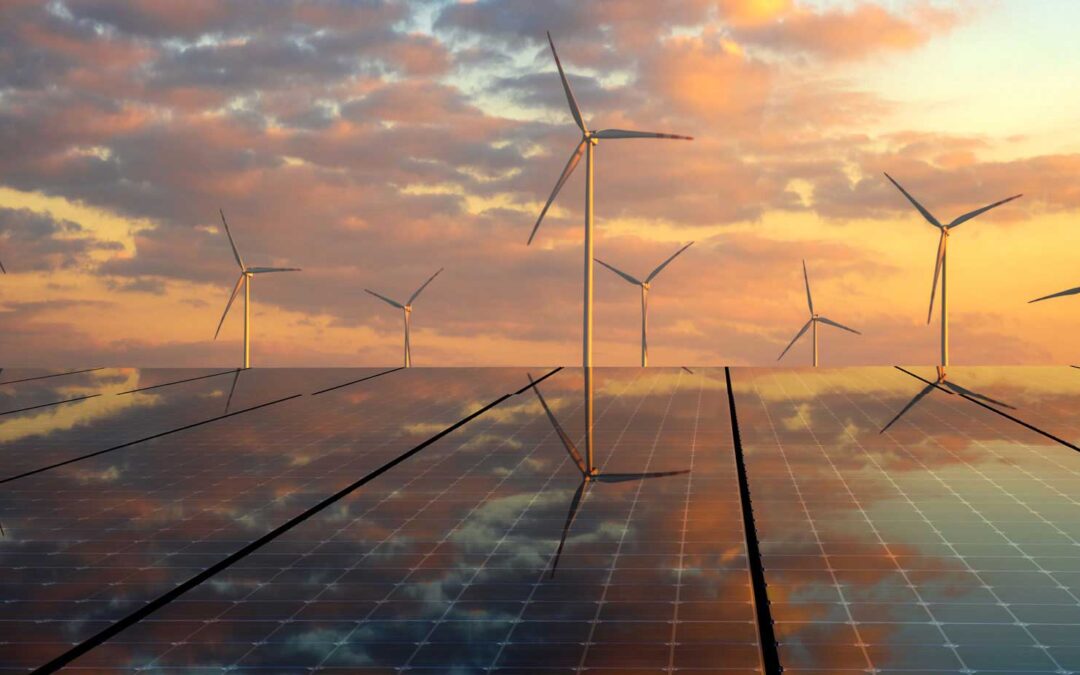
by Michael Vickerman | Aug 19, 2020 | Policy, Public Service Commission, RENEW Wisconsin
In June, the Public Service Commission requested public comments on the latest iteration of its Strategic Energy Assessment (SEA), a study that profiles the state’s electric power industry and surveys how the economic and regulatory landscape will likely evolve over the next six years. The PSC is required by law to update its assessment every two years. The PSC gave the public until August 14th to file comments to the draft study.
In contrast to previous renditions of this process, which were quiet affairs, this year’s draft assessment (Docket 5-ES-110) elicited a veritable torrent of comments from the public. This unprecedented volume of responses reflects a broadening understanding that electric providers are making significant changes to their resource mix to reduce carbon emissions, and that this clean energy transition must continue. With the PSC approving a significant quantity of zero-emission generation in other proceedings, it is heartening to see so many individuals and organizations encouraging the PSC to do more of the same.
Unfortunately, the draft SEA shies away from acknowledging the market realities and environmental constraints that are, today, driving utility procurement decisions quite clearly toward clean energy. This did not go unnoticed. As RENEW noted in its comments, the draft SEA is distinguished more by what is absent from the discussion than by the contents within it.
Chief among the blind spots is the document’s complete silence on climate science and the Governor’s Executive Orders #38 and #52, which enumerated a number of initiatives and goals to put the state on a zero-carbon pathway. Issued in August 2019, Executive Order #38 created a new office within state government, the Office of Sustainability and Clean Energy (OSCE). Over the last nine months, OSCE has been working closely with the Governor’s Task Force on Climate Change, assisting this body in formulating strategies for tackling the effects of climate change in Wisconsin.
OSCE director Maria Redmond submitted comments consisting of recommendations for improving the usefulness and educational value of the SEA.
While reporting on what the utility providers are doing, the PSCW should capitalize on the opportunity to integrate several multi-sector, local, state, and regional efforts to reduce energy consumption, transition to clean energy. The SEA compliments the work of the OSCE and could be a useful tool to measure and verify progress towards meeting our carbon reduction goals. The SEA could also be used to directly address and report on Wisconsin’s progress on reducing the impacts of climate change. As currently written, the assessment does not analyze the overall risks (business as usual) versus the benefits of the transition to a clean energy economy or addressing climate change.
RENEW struck a similar theme in its concluding remarks.
We encourage Commission staff to engage the newly created Office of Sustainability and Clean Energy in a productive way, and find other sources of information beyond the utility responses to data requests. Certainly, RENEW would, if asked, gladly assist Commission staff in the gathering of relevant information prior to the document-drafting process. As noted in the introduction, the Strategic Energy Assessment is the closest thing in the state to a public planning process involving the state’s electric providers. It’s crucially important that this and future iterations of the SEA weave in policy threads that will illuminate pathways to achieving the clean energy goals and objectives that numerous public and private entities in Wisconsin have adopted.
The breadth and volume of comments submitted to the PSC is directly attributable to RENEW’s work to engage stakeholders and the public on the current SEA, highlighted by a webinar organized and led by RENEW policy director Michael Vickerman. The webinar on July 14 presented a primer on the draft SEA, and provided suggested points that could be raised in comments. More than 50 individuals representing numerous organizations in Wisconsin and beyond registered for the webinar. The slide deck prepared for the webinar can be found here.
In 2018, a mere two weeks elapsed between the comment filing deadline and the issuance of the final SEA. This time around, we expect more significant re-writes and additions to the draft.
RENEW thanks the organizations and individuals who weighed in with comments. We are hopeful that the public response to the draft SEA will materialize into needed improvements in the final document.







